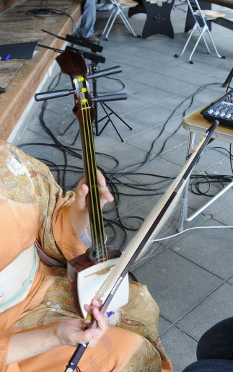Last Saturday I went to a small open air concert in a temple in the centre of Kyoto: koto and shakuhachi. The two instruments go well together, and the flute was the main reason why I wanted to go. I had been to koto concerts before, but never heard a shakuhachi live. And I have to say – I was disappointed by it.
I am not sure what was wrong with the shakuhachi player – a rather old monk from said temple – whether I could not hear him because the microphone was not well-adjusted or functioning (there were a number of total outages throughout the concert) or whether the player himself didn’t have enough breath do make himself heard.
The two koto players were very good though, so my time was not wasted. Interestingly, I was the only non-senior in the audience, something I had not expected at all. But maybe because of this, I was treated to a very special performance: The last song (and the encore) must have been well-known tunes, because at some point, people in the audience started singing along! Man and women alike accompanied (or were accompanied by) the koto and the shakuhachi. It was lovely!
 As a bonus, I learnt something new: In one of the pieces, a so-called kokyu was used. It looks like a half-sized shamisen, but is played like a cello. A kokyu has three silken strings and the bow is a thick handful of horsetail hair. The bow-strings (do you call it like that?) are slack, and you need to use the ring finger of the bow hand to tighten it while you play.
As a bonus, I learnt something new: In one of the pieces, a so-called kokyu was used. It looks like a half-sized shamisen, but is played like a cello. A kokyu has three silken strings and the bow is a thick handful of horsetail hair. The bow-strings (do you call it like that?) are slack, and you need to use the ring finger of the bow hand to tighten it while you play.
This is not easy, and I know that because I was allowed to try it after the concert – obviously the foreigner bonus. To be honest, the sound of the kokyu is not very pleasant to Western ears. It is reminiscent of the Chinese erhu, but the tones of the kokyu are less crisp. I guess this is either because the bow is never really taut, or because of the silken strings.
All in all I had a nice afternoon, even though I will have to try and catch another shakuhachi concert. I hope that I will hear about more concerts and events like this – there is so much to do and learn in Kyoto!
